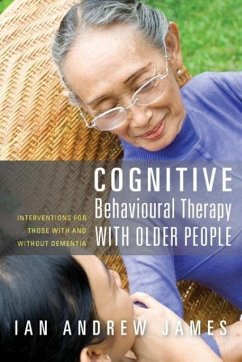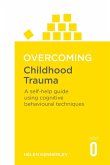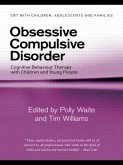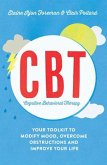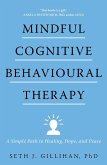Ian Andrew James
Cognitive Behavioural Therapy with Older People
Interventions for Those with and Without Dementia
Ian Andrew James
Cognitive Behavioural Therapy with Older People
Interventions for Those with and Without Dementia
- Broschiertes Buch
- Merkliste
- Auf die Merkliste
- Bewerten Bewerten
- Teilen
- Produkt teilen
- Produkterinnerung
- Produkterinnerung
This book is a detailed guide to using CBT with older people both with and without cognitive difficulties. Reviewing its use in different settings, it covers both conceptual and practical perspectives, and details everything from causes and initial assessment to case formulation and change techniques.
Andere Kunden interessierten sich auch für
![Oxford Guide to Behavioural Experiments in Cognitive Therapy Oxford Guide to Behavioural Experiments in Cognitive Therapy]() Khadj RoufOxford Guide to Behavioural Experiments in Cognitive Therapy77,99 €
Khadj RoufOxford Guide to Behavioural Experiments in Cognitive Therapy77,99 €![Overcoming Childhood Trauma Overcoming Childhood Trauma]() Helen KennerleyOvercoming Childhood Trauma14,99 €
Helen KennerleyOvercoming Childhood Trauma14,99 €![Obsessive Compulsive Disorder Obsessive Compulsive Disorder]() Obsessive Compulsive Disorder58,99 €
Obsessive Compulsive Disorder58,99 €![Art Therapy and Creative Coping Techniques for Older Adults Art Therapy and Creative Coping Techniques for Older Adults]() Susan BuchalterArt Therapy and Creative Coping Techniques for Older Adults42,99 €
Susan BuchalterArt Therapy and Creative Coping Techniques for Older Adults42,99 €![Counselling and Psychotherapy with Older People in Care Counselling and Psychotherapy with Older People in Care]() Felicity ChapmanCounselling and Psychotherapy with Older People in Care58,99 €
Felicity ChapmanCounselling and Psychotherapy with Older People in Care58,99 €![Cognitive Behavioural Therapy (Cbt) Cognitive Behavioural Therapy (Cbt)]() Clair PollardCognitive Behavioural Therapy (Cbt)12,99 €
Clair PollardCognitive Behavioural Therapy (Cbt)12,99 €![Mindful Cognitive Behavioural Therapy Mindful Cognitive Behavioural Therapy]() Seth J. GillihanMindful Cognitive Behavioural Therapy20,99 €
Seth J. GillihanMindful Cognitive Behavioural Therapy20,99 €-
-
-
This book is a detailed guide to using CBT with older people both with and without cognitive difficulties. Reviewing its use in different settings, it covers both conceptual and practical perspectives, and details everything from causes and initial assessment to case formulation and change techniques.
Hinweis: Dieser Artikel kann nur an eine deutsche Lieferadresse ausgeliefert werden.
Hinweis: Dieser Artikel kann nur an eine deutsche Lieferadresse ausgeliefert werden.
Produktdetails
- Produktdetails
- Verlag: Jessica Kingsley Publishers
- Seitenzahl: 258
- Erscheinungstermin: 7. Juni 2013
- Englisch
- Abmessung: 229mm x 152mm x 14mm
- Gewicht: 364g
- ISBN-13: 9781849051002
- ISBN-10: 1849051003
- Artikelnr.: 28346601
- Herstellerkennzeichnung
- Libri GmbH
- Europaallee 1
- 36244 Bad Hersfeld
- gpsr@libri.de
- Verlag: Jessica Kingsley Publishers
- Seitenzahl: 258
- Erscheinungstermin: 7. Juni 2013
- Englisch
- Abmessung: 229mm x 152mm x 14mm
- Gewicht: 364g
- ISBN-13: 9781849051002
- ISBN-10: 1849051003
- Artikelnr.: 28346601
- Herstellerkennzeichnung
- Libri GmbH
- Europaallee 1
- 36244 Bad Hersfeld
- gpsr@libri.de
Ian Andrew James is Head of Newcastle Challenging Behaviour Service and Consultant Clinical Psychologist for Northumberland Tyne and Wear NHS Trust. Having graduated in Psychology from the University of Aberdeen, he undertook a PhD in cognitive psychology at Lancaster University. After completing his clinical training at Newcastle University, he spent four years at Newcastle Cognitive and Behavioural Therapies Centre, undertaking work on therapeutic competence. Ian Andrew James has published extensively in the field of mental health, training and clinical supervision, and is a regular speaker at national and international conferences. He is a lecturer on the Clinical Psychology course at Newcastle University, and now focuses on applying therapy to people with dementia.
Chapter 1. 1.1 Introduction. 1.2 Partitioning - parts 1 to 3. Part 1.
Chapter 2. Patients' Presentations and How CBT Helps. 2.1 Introduction. 2.2
Nature of the mood disorders. 2.3 Nature of standard CBT. 2.4 Working with
people in non-standard CBT formats. 2.5 Conclusion. Chapter 3. Adapting
Therapy for Older People. 3.1 Introduction. 3.2 Two dimensional framework
for categorising presentations. 3.3 Conclusion. Chapter 4. Cognitive
Changes, Executive Functioning, Working Memory and Scripts: Their Relevance
to Therapeutic Engagement. 4.1 Introduction. 4.2 Cognitive changes. 4.3
Executive functioning. 4.4 Working memory. 4.5 Actions of scripts. 4.6
Conclusion. Part 2. Chapter 5. Assessment. 5.1 Introduction. 5.2 Assessment
protocol. 5.3 Cautions regarding the assessment process. 5.4 Measures. 5.5
Conclusion. Chapter 6. Case Formulation. 6.1 Introduction. 6.2 Nature of
formulations. 6.3 Formulations with older people. 6.4 Review of formulation
approaches used with older people. 6.5 Choice of formulation. 6.6 Cautions
regarding use of formulations. 6.7 Conclusion. Chapter 7 Change Techniques.
7.1 Introduction. 7.2 Nature of change. 7.3 Change strategies. 7.4 Process
issues associated with change techniques. 7.5 Modifying core beliefs. 7.6
Cognitive change with the continuum technique. 7.7 Conclusion. Part 3.
Chapter 8 A Case Study in Depression: Mary. 8.1 Introduction. 8.2 Overview
of the case. 8.3 Review of the work undertaken with Mary. 8.4 Conclusion.
Chapter 9 Assessing and Developing Clinical Competence. 9.1 Introduction.
9.2 The Cognitive Therapy Scale-Revised. 9.3 Conclusion. Chapter 10. Use of
Psychotherapy in the Treatment of Challenging Behaviours in Care
Facilities: A Staff-Centred, Person-Focused Approach. 10.1 Introduction.
10.2 Description of the NCBS and its treatment philosophy. 10.3 Overview of
the case. 10.4 Protocol of the Newcastle approach. 10.5 Process and
structural features of the assessment phase. 10.6 Information Sharing
Session (ISS) and goal-setting process. 10.7 Formulation. 10.8 Treatment
and outcome. 10.9 Reflections. Chapter 11.Concluding Comments 11.1
Introduction. 11.2 Working with carers. 11.3 Alternative models to CBT in
the treatment of depression. 11.4 IAPT: Provision of Mental Health Services
for Older People. 11.5 Concluding comments and reflections. Appendix 1:
Disorder-specific conceptual models. Appendix 2: A training manual for
promoting therapeutic competence. References.
Chapter 2. Patients' Presentations and How CBT Helps. 2.1 Introduction. 2.2
Nature of the mood disorders. 2.3 Nature of standard CBT. 2.4 Working with
people in non-standard CBT formats. 2.5 Conclusion. Chapter 3. Adapting
Therapy for Older People. 3.1 Introduction. 3.2 Two dimensional framework
for categorising presentations. 3.3 Conclusion. Chapter 4. Cognitive
Changes, Executive Functioning, Working Memory and Scripts: Their Relevance
to Therapeutic Engagement. 4.1 Introduction. 4.2 Cognitive changes. 4.3
Executive functioning. 4.4 Working memory. 4.5 Actions of scripts. 4.6
Conclusion. Part 2. Chapter 5. Assessment. 5.1 Introduction. 5.2 Assessment
protocol. 5.3 Cautions regarding the assessment process. 5.4 Measures. 5.5
Conclusion. Chapter 6. Case Formulation. 6.1 Introduction. 6.2 Nature of
formulations. 6.3 Formulations with older people. 6.4 Review of formulation
approaches used with older people. 6.5 Choice of formulation. 6.6 Cautions
regarding use of formulations. 6.7 Conclusion. Chapter 7 Change Techniques.
7.1 Introduction. 7.2 Nature of change. 7.3 Change strategies. 7.4 Process
issues associated with change techniques. 7.5 Modifying core beliefs. 7.6
Cognitive change with the continuum technique. 7.7 Conclusion. Part 3.
Chapter 8 A Case Study in Depression: Mary. 8.1 Introduction. 8.2 Overview
of the case. 8.3 Review of the work undertaken with Mary. 8.4 Conclusion.
Chapter 9 Assessing and Developing Clinical Competence. 9.1 Introduction.
9.2 The Cognitive Therapy Scale-Revised. 9.3 Conclusion. Chapter 10. Use of
Psychotherapy in the Treatment of Challenging Behaviours in Care
Facilities: A Staff-Centred, Person-Focused Approach. 10.1 Introduction.
10.2 Description of the NCBS and its treatment philosophy. 10.3 Overview of
the case. 10.4 Protocol of the Newcastle approach. 10.5 Process and
structural features of the assessment phase. 10.6 Information Sharing
Session (ISS) and goal-setting process. 10.7 Formulation. 10.8 Treatment
and outcome. 10.9 Reflections. Chapter 11.Concluding Comments 11.1
Introduction. 11.2 Working with carers. 11.3 Alternative models to CBT in
the treatment of depression. 11.4 IAPT: Provision of Mental Health Services
for Older People. 11.5 Concluding comments and reflections. Appendix 1:
Disorder-specific conceptual models. Appendix 2: A training manual for
promoting therapeutic competence. References.
Chapter 1. 1.1 Introduction. 1.2 Partitioning - parts 1 to 3. Part 1.
Chapter 2. Patients' Presentations and How CBT Helps. 2.1 Introduction. 2.2
Nature of the mood disorders. 2.3 Nature of standard CBT. 2.4 Working with
people in non-standard CBT formats. 2.5 Conclusion. Chapter 3. Adapting
Therapy for Older People. 3.1 Introduction. 3.2 Two dimensional framework
for categorising presentations. 3.3 Conclusion. Chapter 4. Cognitive
Changes, Executive Functioning, Working Memory and Scripts: Their Relevance
to Therapeutic Engagement. 4.1 Introduction. 4.2 Cognitive changes. 4.3
Executive functioning. 4.4 Working memory. 4.5 Actions of scripts. 4.6
Conclusion. Part 2. Chapter 5. Assessment. 5.1 Introduction. 5.2 Assessment
protocol. 5.3 Cautions regarding the assessment process. 5.4 Measures. 5.5
Conclusion. Chapter 6. Case Formulation. 6.1 Introduction. 6.2 Nature of
formulations. 6.3 Formulations with older people. 6.4 Review of formulation
approaches used with older people. 6.5 Choice of formulation. 6.6 Cautions
regarding use of formulations. 6.7 Conclusion. Chapter 7 Change Techniques.
7.1 Introduction. 7.2 Nature of change. 7.3 Change strategies. 7.4 Process
issues associated with change techniques. 7.5 Modifying core beliefs. 7.6
Cognitive change with the continuum technique. 7.7 Conclusion. Part 3.
Chapter 8 A Case Study in Depression: Mary. 8.1 Introduction. 8.2 Overview
of the case. 8.3 Review of the work undertaken with Mary. 8.4 Conclusion.
Chapter 9 Assessing and Developing Clinical Competence. 9.1 Introduction.
9.2 The Cognitive Therapy Scale-Revised. 9.3 Conclusion. Chapter 10. Use of
Psychotherapy in the Treatment of Challenging Behaviours in Care
Facilities: A Staff-Centred, Person-Focused Approach. 10.1 Introduction.
10.2 Description of the NCBS and its treatment philosophy. 10.3 Overview of
the case. 10.4 Protocol of the Newcastle approach. 10.5 Process and
structural features of the assessment phase. 10.6 Information Sharing
Session (ISS) and goal-setting process. 10.7 Formulation. 10.8 Treatment
and outcome. 10.9 Reflections. Chapter 11.Concluding Comments 11.1
Introduction. 11.2 Working with carers. 11.3 Alternative models to CBT in
the treatment of depression. 11.4 IAPT: Provision of Mental Health Services
for Older People. 11.5 Concluding comments and reflections. Appendix 1:
Disorder-specific conceptual models. Appendix 2: A training manual for
promoting therapeutic competence. References.
Chapter 2. Patients' Presentations and How CBT Helps. 2.1 Introduction. 2.2
Nature of the mood disorders. 2.3 Nature of standard CBT. 2.4 Working with
people in non-standard CBT formats. 2.5 Conclusion. Chapter 3. Adapting
Therapy for Older People. 3.1 Introduction. 3.2 Two dimensional framework
for categorising presentations. 3.3 Conclusion. Chapter 4. Cognitive
Changes, Executive Functioning, Working Memory and Scripts: Their Relevance
to Therapeutic Engagement. 4.1 Introduction. 4.2 Cognitive changes. 4.3
Executive functioning. 4.4 Working memory. 4.5 Actions of scripts. 4.6
Conclusion. Part 2. Chapter 5. Assessment. 5.1 Introduction. 5.2 Assessment
protocol. 5.3 Cautions regarding the assessment process. 5.4 Measures. 5.5
Conclusion. Chapter 6. Case Formulation. 6.1 Introduction. 6.2 Nature of
formulations. 6.3 Formulations with older people. 6.4 Review of formulation
approaches used with older people. 6.5 Choice of formulation. 6.6 Cautions
regarding use of formulations. 6.7 Conclusion. Chapter 7 Change Techniques.
7.1 Introduction. 7.2 Nature of change. 7.3 Change strategies. 7.4 Process
issues associated with change techniques. 7.5 Modifying core beliefs. 7.6
Cognitive change with the continuum technique. 7.7 Conclusion. Part 3.
Chapter 8 A Case Study in Depression: Mary. 8.1 Introduction. 8.2 Overview
of the case. 8.3 Review of the work undertaken with Mary. 8.4 Conclusion.
Chapter 9 Assessing and Developing Clinical Competence. 9.1 Introduction.
9.2 The Cognitive Therapy Scale-Revised. 9.3 Conclusion. Chapter 10. Use of
Psychotherapy in the Treatment of Challenging Behaviours in Care
Facilities: A Staff-Centred, Person-Focused Approach. 10.1 Introduction.
10.2 Description of the NCBS and its treatment philosophy. 10.3 Overview of
the case. 10.4 Protocol of the Newcastle approach. 10.5 Process and
structural features of the assessment phase. 10.6 Information Sharing
Session (ISS) and goal-setting process. 10.7 Formulation. 10.8 Treatment
and outcome. 10.9 Reflections. Chapter 11.Concluding Comments 11.1
Introduction. 11.2 Working with carers. 11.3 Alternative models to CBT in
the treatment of depression. 11.4 IAPT: Provision of Mental Health Services
for Older People. 11.5 Concluding comments and reflections. Appendix 1:
Disorder-specific conceptual models. Appendix 2: A training manual for
promoting therapeutic competence. References.

